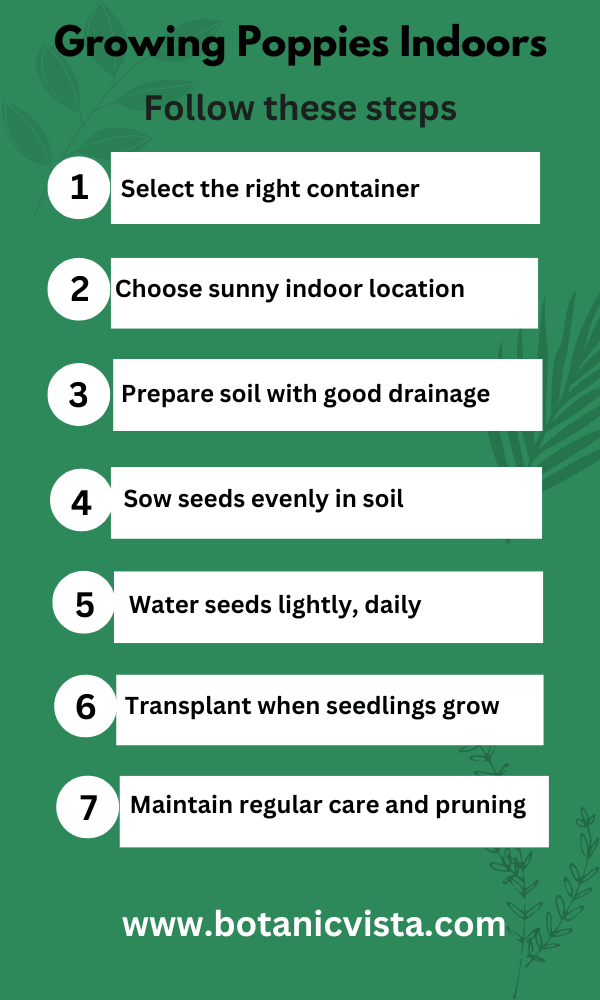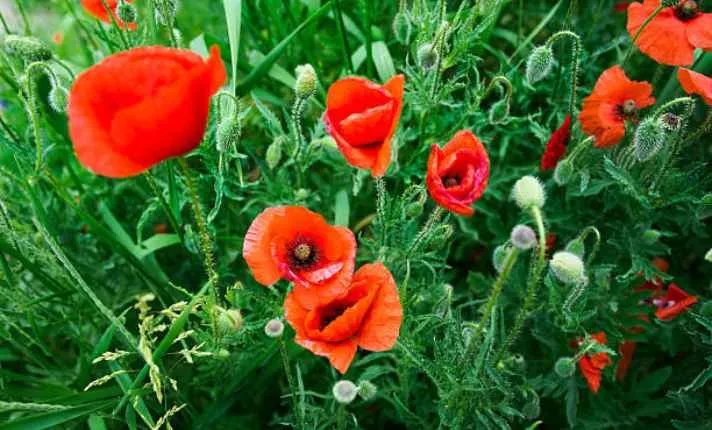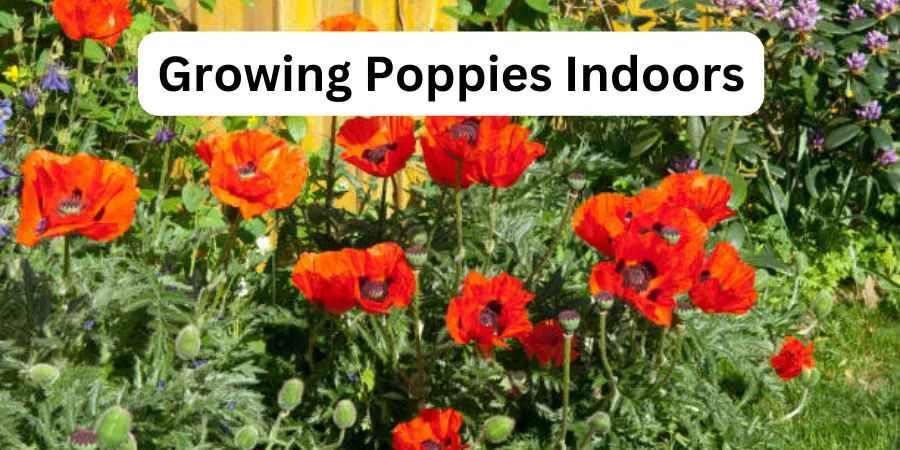Last Updated on July 2, 2025 by Jocelyn
Poppies are beautiful flowering plants from the Papaveraceae family, known for their colorful petals in shades of red, pink, white, and purple. Popular indoor varieties include Papaver somniferum and Papaver rhoeas.
Their tiny black seeds are often used in food, and the plants can be annual, biennial, or perennial. Poppies also have a long history of being used for medicine and are important symbols of remembrance in places like Flanders, Belgium and Canada.
To grow poppies indoors, place them in a sunny spot with at least six hours of direct light and use well-draining soil to keep roots healthy.
Start seeds in peat pots to boost germination, which usually happens within 20 days, and maintain a cool room temperature between 55 and 65 degrees Fahrenheit.

Table of Contents
ToggleConditions for Growing Poppies Indoors
Knowing how to grow poppies indoors is essential for gardeners. Choose the right type that can bloom indoors. Map out the planting location that receives direct sunlight daily.
It’s important for poppies to get at least six hours of full sun each day. This ensures they remain healthy and can bloom beautifully.
- Complete Sunlight Requirements
Use a well-draining soil mix when planting your poppies. Good drainage is crucial for preventing root rot. Select a location that has cooler conditions at night. Cool nights help the poppies to flourish.
- Importance of Good Drainage
Planting in early April can be beneficial, as the weather is suitable for poppies. They typically start blooming by June. Ensure the hardiness zone matches the needs of the poppies.
Types of Poppies Suitable for Indoor Growth
Growing poppies indoors can bring a touch of elegance and color to your home. Different types of poppies have unique characteristics that make them suitable for indoor cultivation. Choosing the right variety can ensure a successful and flourishing indoor garden.
Let’s explore some popular poppy types and their specific needs for indoor growth.
| Poppy Type | Description | Growing Conditions | Bloom Time | Special Features |
| Papaver somniferum | Known as Opium poppy, has purple color flowers | Prefers well-draining soil and full sun | Spring, Summer | Seeds used in baking, parts are toxic |
| California Poppy | Features golden cups and blue-green leaves | Thrives in dry heat and cool nights, sandy soil | Spring, Summer | The bright color palette, suitable for cool nights |
| Oriental Poppy | Offers large, colorful blooms | Grows well in sandy soil and benefits from cool nights | Late Spring, Early Summer | Ideal as a cut flower |
| Iceland Poppy | Cheerful blooms in white, orange, yellow | Prefers cooler conditions and full sun | Early Spring | Bright color palette, suitable for cool nights |
How to Plant Poppies Indoors
With a bit of effort and the right care, you can enjoy these stunning blooms year-round. Follow these simple steps to create the perfect environment for your poppies to flourish indoors.
Here’s how to start your indoor poppy garden and watch it blossom!
1. Select the Right Container
Choose a wide, shallow container with drainage holes at the bottom. This helps the roots get enough air and prevents water from sitting at the bottom.
2. Choose the Best Location
Find a spot that gets at least 6 hours of direct sunlight daily. If natural light is limited, use grow lights to provide adequate light.
3. Prepare the Soil
Mix well-draining soil with organic matter, perlite, and vermiculite. This mix will improve the soil structure and support healthy growth.
4. Sow the Seeds
Sow poppy seeds like Papaver somniferum or Papaver rhoeas directly into the soil. Follow the instructions on the seed packet for the best results. Sow thinly and cover the seeds with a thin layer of soil.
5. Water the Seeds
After sowing, gently moisten the soil. Avoid overwatering to prevent root rot. Keep the soil moist but not soggy and allow it to dry slightly between watering.
6. Start Indoors and Transplanting
Begin indoors about eight weeks before the last frost. Plan to transplant after hardening off for about four weeks. Use a heat mat to help seeds sprout if necessary. Transplant on an overcast day or when it is rainy to reduce stress on the plants.
7. Use Pots and Containers
Poppies can be grown in various pots and containers. California poppy and Iceland poppy are good choices. Place the pots on a window sill with southern exposure. Keep the soil surface sown and mist lightly to avoid washing off the seeds.
8. Timing and Protection
In Zone 5, start seeding in March or April. Use a row cover to protect seeds from birds and keep the soil moist.
9. Transplanting to a Garden Bed
When transplanting to a garden bed, choose a spot with full sun. Dig a divot for each root ball and ensure the soil level is correct. Use a hose shower to water the plants gently.
Explore my other guides for practical gardening tips:
- Growing bamboo in pots
- Growing broccoli in pots
- Growing ranunculus in pots
- Growing pumpkins in containers
Caring for Indoor Poppies
Indoor poppies can add a touch of elegance to any room. To keep these beautiful flowers at their best, it’s important to manage sunlight, soil moisture, and nutrients carefully.

Here’s a quick guide to ensure your poppies stay healthy and flourishing.
1. Soil Preparation and Testing
When growing poppies indoors, start with good compost mixed with leaf mold. This helps build strong root systems. Conduct a soil test to check the pH level and make the necessary amendments.
2. Ensuring Sunlight and Drainage
Keep the soil moist but ensure it has good drainage to avoid rot. A mix of sand, gravel, and clay works well. Place poppies in an area with full sun for optimal growth. Use a greenhouse or row cover during cold weather for protection.
3. Managing Seedlings
Thin seedlings to avoid crowding and improve flower yields. Remove extraneous seedlings early to give them enough space.
4. Regular Weeding
Weed the poppy bed frequently. Remove weeds to prevent pests like caterpillars and to keep the foliage healthy.
5. Consistent Watering and Fertilizing
Water once a week to keep the soil moist. Apply all-purpose fertilizer during the growing season to enhance flower production.
6. Disease Prevention
Prevent fungal diseases by ensuring good air spacing. Watch out for southern blight and rot. Remove affected plants immediately.
7. Deadheading for Continuous Blooms
Deadhead regularly to encourage new blooms. Use garden shears or fingers to remove dead flowers and maintain a vibrant display.
8. Organic Growth Techniques
Use an organic medium to enhance microbial activity in the soil. This promotes healthy growth. Protect your poppies during overwintering with row covers and greenhouses.
By following these tips, your indoor poppies will thrive and bring beauty to your home all year round.
FAQ’s
Q: Do Poppy Seeds Grow Back Every Year?
A: Yes, poppy seeds grow back every year. These hardy plants often self-seed naturally, making them a great addition to your garden. This bonus helps in attracting bees and butterflies.
Q: Can I Just Throw Poppy Seeds on the Ground?
A: When growing poppies indoors, sprinkle the seeds on top of the soil lightly. This helps them establish better and ensures an abundance of healthy plants.
Q: How to Grow Poppy Seeds Indoors?
A: To grow poppies indoors, fill seed-starting trays with a moist mix, surface-sow the seeds, and press them gently into the soil. Mist the soil lightly and keep it moist.
Q: What Month Do Poppies Bloom?
A: Poppies typically bloom from mid-March to May. In California, their peak bloom period is in the early spring, often occurring by late spring. Start them indoors during the winter for best results.
Q: What Is the Best Potting Mix for Poppies?
A: For growing poppies indoors, add 2 parts peat moss for water retention, 3 parts coconut coir for moisture, and 1 part perlite for air and breathability. Include 1 part nutrient-rich base for healthy roots.
Q: What Size Container for Poppies?
A: Use a potting mix with good drainage for growing poppies indoors. Choose planters with a diameter of 10-12 inches for small poppies and 16 inches for large varieties. One large pot can be a focal point in your home.
Conclusion
Growing poppies indoors can be easy and enjoyable. You can learn to keep these flowers healthy with some simple steps. Follow these tips to enjoy their beauty and color.
First, choose a sunny space for your poppies. They need full sun to grow well. Mind that they get at least 6 hours of sunlight daily. Next, make sure your pots have good drainage. Poppies don’t like too much water. Water them regularly, but let the soil dry out between watering.
Select varieties of poppies that are suitable for indoor growing. There are several kinds that do well inside. With regular care, your poppies will grow strong and healthy.

